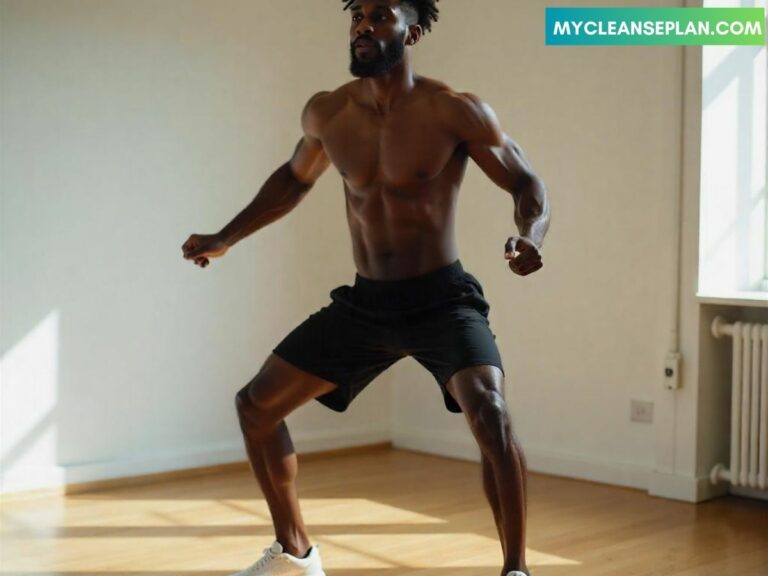Strength Training for Longevity
Regular exercise is vital for staying active and mobile as we get older. By focusing on strength training, I’m making a smart choice for a longer, healthier life. This article will dive into the benefits and how to start and keep up with strength training.
Reflecting on my journey to a healthier life, I see how important physical activity is. Strength training has been a key part of my routine. It’s not just for building muscle; it’s about living better and longer.
Key Takeaways

The Science Behind Muscle Strength and Aging

The link between muscle strength and aging is key in longevity research. Muscle mass is vital for our lifespan and health. It plays a big role in how long we live and how well we stay healthy.
How Muscle Mass Affects Lifespan
Research shows that more muscle mass means a longer, healthier life. Muscle isn’t just for moving around; it affects our metabolism and hormones too. Keeping muscle through strength training helps us live longer.

Research on Resistance Training and Mortality Rates
Studies show that resistance training boosts life expectancy. It increases muscle and lowers death risk. This is because it improves heart health, insulin use, and other aging signs.
Biological Markers Improved by Strength Training
Strength training makes aging healthier by improving key markers. These include:
- Insulin sensitivity
- Bone density
- Inflammation reduction
- Improved lipid profiles
| Biological Marker | Effect of Strength Training |
|---|---|
| Insulin Sensitivity | Improved glucose uptake |
| Bone Density | Increased bone mineral density |
| Inflammation | Reduced systemic inflammation |
Understanding muscle strength and aging helps us see why strength training is important. It’s a key to living longer and healthier.
Strength Training for Longevity: A Complete Approach

To get the most out of longevity, a well-rounded strength training program is key. It boosts physical health and overall well-being.
The Longevity-Muscle Connection
Studies link muscle mass to longevity. As we age, keeping muscle through strength training is vital for health.
Muscle mass is key for metabolic health, mobility, and fighting chronic diseases. Strength training boosts muscle and longevity.
How Resistance Training Slows Biological Aging
Resistance training slows biological aging. It improves cellular health and boosts the body’s repair.
| Benefits | Description |
|---|---|
| Improved Cellular Health | Enhanced cellular function and reduced oxidative stress |
| Increased Muscle Mass | Better mobility and reduced risk of chronic diseases |
| Enhanced Metabolic Health | Improved insulin sensitivity and glucose metabolism |
Long-term Benefits for Quality of Life
Regular strength training boosts quality of life over time. It keeps physical function, lowers chronic disease risk, and improves mental health.
With a complete strength training program, people can enjoy these benefits and enhance their life quality.
Physiological Changes That Occur With Aging

As we age, our bodies change in many ways. These changes can affect our strength, how we move, and our independence. It’s important to know and deal with these changes.
Sarcopenia: Age-Related Muscle Loss
Sarcopenia is a big concern because it makes our muscles weaker. This can lead to less mobility and a higher chance of falling. Resistance training helps by keeping our muscles strong.
Bone Density Reduction and Osteoporosis Risk
Our bones also get weaker with age, raising the risk of osteoporosis. Strength training can help keep our bones strong. This reduces the chance of breaking bones.
Hormonal and Metabolic Changes
Hormonal shifts, like lower testosterone and growth hormone, can lower our energy and affect our metabolism. Regular strength training can boost our insulin sensitivity and metabolism.
Neurological Adaptations
Our brains also change with age, making us less coordinated and balanced. This increases the risk of falls. Exercise programs that focus on balance and coordination can help.
It’s key to understand these changes to create good strength training plans. This helps fight these changes and supports healthy aging.
Key Benefits of Strength Training for Healthy Aging

Regular strength training can greatly improve your physical health. It also lowers the risk of age-related diseases. This is a key part of staying fit and healthy as you age.
Improved Muscle Mass and Functional Strength
Strength training helps build muscle and boost strength. As we get older, we lose muscle, a condition called sarcopenia. This training helps keep muscle strong, improving physical function and reducing injury risks.
Enhanced Bone Density and Joint Health
It also helps keep bones strong, lowering osteoporosis and fracture risks. Strengthening muscles and bones around joints improves joint health. This reduces the chance of conditions like osteoarthritis.
Better Metabolic Health and Insulin Sensitivity
Strength training boosts metabolic health by improving insulin sensitivity. This lowers the risk of type 2 diabetes. It also aids in weight management, improving overall metabolic health.
Reduced Risk of Age-Related Diseases
Strength training can also lower the risk of heart disease, some cancers, and cognitive decline. Adding it to your routine can greatly improve your health. It supports healthy aging.
In summary, strength training offers many benefits for healthy aging. These include better muscle and bone health, improved metabolic health, and a lower risk of age-related diseases.
By making strength training a regular part of your fitness routine, you can actively work towards maintaining your physical health and increasing your lifespan.
Essential Strength Training Exercises for Longevity

As we get older, it’s key to add the right strength training to our routine. This helps keep us healthy and strong. A good strength training plan boosts muscle, bone density, and function, all important for aging well.
Compound Movements
Compound movements work many muscles at once. They’re great for building strength and muscle. Examples are squats, deadlifts, and push and pull exercises.
Squats and Variations
Squats are essential for working the legs, glutes, and core. You can do bodyweight squats, goblet squats, or barbell squats. Squats boost functional strength, improve mobility, and help bones stay strong.
Deadlifts and Hip Hinges
Deadlifts work the back, legs, and glutes. It's important to do them right to avoid injury. Hip hinges, like Romanian deadlifts, also strengthen the back and improve flexibility.
Push and Pull Movements
Push-ups and bench presses work the chest, shoulders, and triceps. Rows and pull-ups target the back, shoulders, and arms. These exercises keep the upper body strong and balanced.
Functional Exercises for Daily Living
Adding functional exercises to your routine makes daily tasks easier. They improve balance, stability, and grip, lowering the chance of falls and injuries.
Balance and Stability Training
Exercises like single-leg stands and balance boards boost balance and reduce fall risk. Planks and stability ball exercises strengthen the core and improve stability.
Grip Strength Development
Grip strength is vital for overall strength and function. Using grip strengthening devices, doing towel pull-ups, and plate pinches can enhance grip. This supports daily activities and health.
By doing these strength training exercises, you can live longer and better. A study shows that “Resistance training is a key part of a good exercise plan for older adults. It improves function and lowers disease risk”
Resistance training is a key part of a good exercise plan for older adults. It improves function and lowers disease risk
How to Start Strength Training at Different Life Stages

It’s never too late to start strength training. It offers many benefits, no matter when you begin. This exercise is great for all ages and fitness levels. It helps improve health and increase life expectancy.
Beginning in Your 30s and 40s
In your 30s and 40s, your muscle and strength are likely at their peak. But, you might start to lose muscle and bone density with age.
Starting strength training now can help keep your muscles and bones strong. Do compound exercises like squats, deadlifts, and bench presses to boost your strength.
Starting in Your 50s and 60s
In your 50s and 60s, muscle and bone loss speeds up. Strength training is key to fight these changes. Adjust your workouts to fit your abilities. Use resistance bands or lighter weights with more reps.
Strength Training for Seniors (70+)
Seniors over 70 can also benefit from strength training. Focus on exercises that improve daily strength, like chair squats and wall push-ups. These help keep you independent and reduce fall risks.
Adapting Exercises for Physical Limitations
Everyone can adapt strength training to fit their needs, no matter their age. Use lighter weights or resistance bands if needed. Modify exercises to avoid injury. A healthcare professional or certified trainer can help create a personalized plan.
Starting strength training at any age and adjusting it to your needs can greatly improve your life. It leads to a longer, healthier life.
Creating a Sustainable Strength Training Program

To get the most out of strength training for longevity, creating a lasting program is key. This means focusing on several important aspects to reach your health goals over time.
Frequency and Volume Considerations
When planning your strength training, think about how often and how much you do. How often you train is called frequency.
The amount of work in each session is called volume. Studies show training each major muscle group 2-3 times a week is best for building strength and muscle.
It’s important to balance how often and how much you train to avoid overdoing it. A good program might include 3-4 sets of each exercise and 8-12 reps. This is usually enough for most adults.
| Training Frequency | Volume per Session | Expected Outcome |
|---|---|---|
| 2-3 times per week | 3-4 sets per exercise | Improved strength and muscle mass |
| 4-5 times per week | 4-5 sets per exercise | Enhanced muscle hypertrophy and strength |
Progressive Overload Principles
Progressive overload is a key principle in strength training. It means slowly increasing the weight or resistance to challenge your muscles and help them grow stronger. You can do this by adding more weight, reps, or sets over time.
Progressive overload is essential for ongoing improvement and avoiding plateaus. By gradually increasing the challenge, your strength training stays effective and helps you keep getting stronger.
Recovery and Adaptation Strategies
Recovery is critical for muscle repair and adaptation after strength training. Make sure to get enough sleep, eat right, and rest between workouts for the same muscle group.
Using foam rolling, stretching, and contrast showers can also help with recovery. These methods can make your training program more effective.
Tracking Progress and Making Adjustments
Keeping track of your progress is important to see if your strength training is working. Look at strength gains, body composition changes, and health markers.
By regularly checking your progress and tweaking your program, you can keep your strength training on track with your long-term health and longevity goals.
Safety and Injury Prevention for Lifelong Training

To get the most out of strength training, safety and injury prevention are key. They help us keep training as we get older and stay healthy.
Proper Form and Technique Fundamentals
Learning proper form and technique is vital for safe strength training. It means knowing how to do exercises right, using the right weights, and paying attention to how your body is positioned. Always start with lighter weights to learn the movements first, then add more weight.
Working Around Joint Issues and Chronic Conditions
Many people deal with joint problems or chronic conditions that make some exercises hard. It’s important to adjust your training to fit these challenges.
For example, if you have knee issues, you might do more upper body or lower body exercises that are easier on your knees.
When to Seek Professional Guidance
Knowing when to get help is important for avoiding injuries. If you’re new to strength training or have health concerns, talking to a fitness expert or doctor is a good idea. They can help create a program that’s right for you and offer support and changes as needed.
Equipment and Environment Considerations
The safety of where you train is as important as the exercises you do. Make sure equipment is in good shape, wear the right shoes and clothes, and watch your space to avoid accidents. A clean, well-organized, and well-lit place to train can help prevent injuries.
Nutrition to Support Strength Training for Older Adults

As we get older, eating right is key when we exercise. Good food helps our muscles stay strong and makes our workouts better.
Protein Requirements as We Age
Protein is vital for fixing and growing muscles. Older folks need more protein to keep their muscles.
I suggest eating 1.2 to 1.6 grams of protein per kilogram of body weight each day. Eat it in three main meals and one or two snacks.
Micronutrients for Muscle and Bone Health
Some nutrients are also important for muscles and bones. These include:
- Calcium and Vitamin D for strong bones
- Magnesium and Potassium for muscle health
- Omega-3 fatty acids to fight inflammation
Hydration and Recovery Nutrition
Drinking enough water is key for staying fit and recovering. Older adults should drink at least 8-10 glasses of water per day. After working out, mix carbs and protein for recovery. A good mix is 2:1 or 3:1 carbs to protein.
Supplements Worth Considering
Even with a good diet, some supplements can help. These include:
- Protein supplements for easy protein
- Vitamin D supplements for bones
- Omega-3 supplements for less inflammation
Combining Strength Training With Other Longevity Practices

To get the most out of strength training for aging well, mix it with other practices. A full plan that includes lifestyle changes can greatly boost health and life span.
Cardiovascular Exercise Integration
Adding cardio to strength training boosts heart health and physical function. You can do brisk walks, cycling, or swimming alongside your strength workouts.
Flexibility and Mobility Work
Adding exercises for flexibility and mobility can help move better and avoid injuries. Yoga or Pilates can make your strength training even better by improving how flexible you are.
Key benefits of flexibility and mobility work include:
- Improved balance and coordination
- Enhanced athletic performance
- Reduced risk of falls and injuries
Stress Management and Sleep Optimization
It’s key to manage stress and get good sleep for health and longevity. Meditation, deep breathing, or mindfulness can help with stress.
Community and Social Engagement
Being part of community activities or social events is good for your mind and heart. Strong social ties can make life better overall.
FAQ Of Strength Training for Longevity
What is the importance of strength training for longevity?
Strength training is key for a long life. It keeps muscles, bones, and strength in check. This reduces disease risk and boosts life quality.
How does strength training impact muscle mass and lifespan?
Studies show more muscle mass means a longer, healthier life. Muscle is vital for longevity.
What are the benefits of resistance training for older adults?
Resistance training boosts health and life span in seniors. It improves aging markers and quality of life, helping them stay independent.
How can I start strength training if I’m over 70?
Starting strength training at 70 is fine. Seniors should create a program that fits their needs and abilities. Adjust exercises to fit any physical limits.
What nutritional considerations are important for older adults engaging in strength training?
Older adults need enough protein for muscle health. They also need essential nutrients for bones and muscles. Proper hydration and recovery nutrition are key.
Can strength training be combined with other longevity practices?
Yes, mixing strength training with cardio, flexibility, stress management, sleep, and social activities boosts longevity even more.
How often should I do strength training exercises?
Strength training frequency varies by goal and need. Aim for two to three times a week. This allows for recovery.
What are some essential strength training exercises for longevity?
Focus on compound movements like squats and deadlifts. Also, do exercises that improve balance and grip. These help prevent falls and keep independence.
Conclusion: Embracing Strength for a Longer, Healthier Life
As we get older, adding strength training to our routine is key. It helps keep us physically fit, independent, and healthy. By choosing the right strength training, we can live better and longer.
Strength training for seniors is more than just keeping muscles strong. It’s about a whole approach to aging well. This includes adding cardio, flexibility, and stress control to get the best results.
Starting strength training early can greatly improve our health. It lowers the risk of diseases and boosts our overall well-being.
Learning about strength training’s benefits shows us it’s always a good time to begin. Every effort we make can lead to a longer, healthier life






